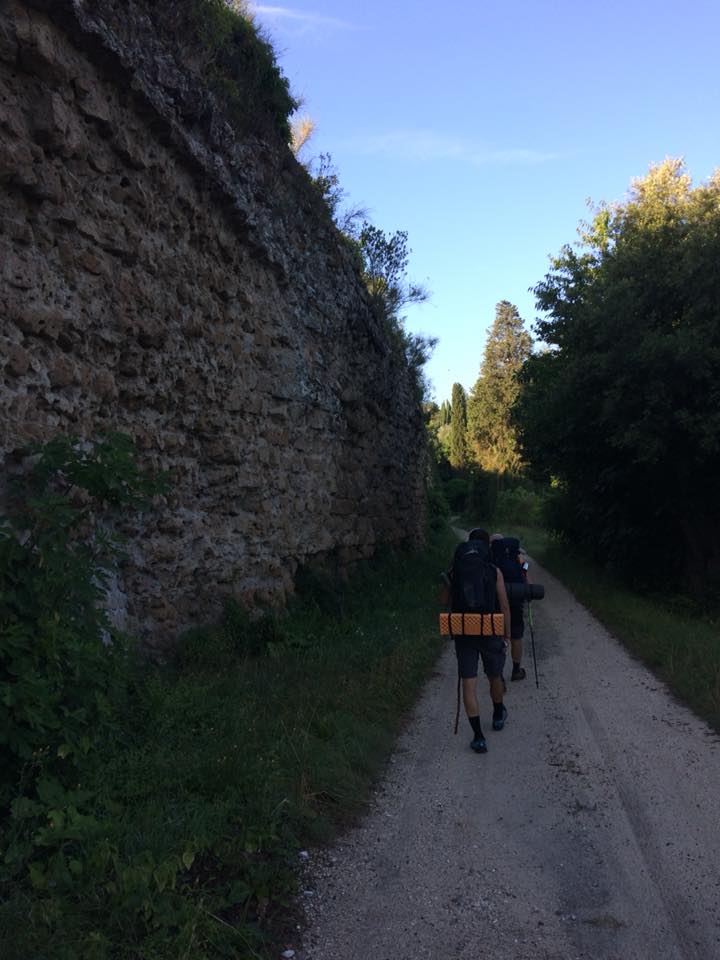17 days on the Via Romea Germanica (Part II)
Read Part I HERE.
The next day saw me set off for Valle Santa, this was to be a very long day. I traveled through forest paths where I frequently noticed the tracks of wild boar in the soft clay - as well as the dried up mud wallows they'd undoubtedly made earlier in the morning. I crossed little streams, in one of which I caught a glimpse of a baby snake slithering under the cover of a submerged leaf. At two points I took the wrong path and had to double back. On one of these wrong turns I came upon a pair of deer in an open field along the slope, the stag catching my eye standing on a crest of earth in the sunlight, the doe darting quickly into the shadow of the woods. Their calls, perhaps mainly the stag, had initially unnerved me as I walked through those woods and fields - not knowing exactly what kind of animals prowled these mountains. Once I even lost the path I was trying to double back on and was obliged to scramble up a wooded slope to regain it. Not exactly pleasant, but I continuously reminded myself of all the calories accrued from piadina and pizza and gelato that I was burning and this helped make the pain and exasperation largely bearable. Late in the morning I discovered a broken tower on a little hill; I took a break inside its empty structure before moving on. I then descended past a lonely mountain top church to a small town and stopped for espresso and paninis before pushing on past Bagno di Romagna to the Sera pass.
I followed the highway for a long time in the valley I’d descended into. At one point on my left there was a field of what appeared to be hawks or kites - just hanging out - it was strange, but interesting - I supposed they must be scavenging something left behind by Italian truckers. I followed the highway out of town and to the right at a fork, continuing under a concrete bridge - the orange arrows marking the VRG leading me into a narrow ravine with a silty mountain stream running down its base, from there I began the ascent of a slope- that lead to an exposed face of crumbling grey stone, and another and another. Eventually, I walked along a bare set of peaks and slopes that were all crumbling naked stone, I’d never seen anything like it before. Eventually I passed through, marveling at the mountain vistas afforded me by that strange grey terrain, to find an empty stone cottage and the remnants of a campfire - this would be a place to stay alone I thought, after exploring and finding a tap of water situated nearby, I thought about it - but the prospect did not appeal to me. I had more in me still; it felt too early in the day to stop. I can only imagine what the stars would have looked like in that place-but I moved on. Shortly beyond the cottage a sign informed me I should only proceed understanding that it was still a long way to the next town and only experienced trekkers should continue on over the sera pass from Forli-Cesena into Tuscany. I thought about that little cottage on top of the hill-but with mixed feelings decided to press on.
The Sera pass was one of the most challenging sections of the Via Romea Germanica in my first stages. I followed an ancient muleteer's path as it went back and forth; zigzagging up a steep mountainside for what seemed like an eternity, before I finally reached the summit; where a huge stone marked the border between the provinces of Forli-Cesena and Tuscany. I was now officially in Tuscany. I descended the far side of the pass into Valle Santa - noticing from a distance the red roofs of Corezzo, a remote village standing out against the forested slopes. The village was now used primarily for vacationing. A light rain began to fall and I was very glad to see that village - even though it was far away. The weight of my pack had begun to wear me down and the thought of a pint of beer or decanter of wine and a pizza at a country restaurant drove me on. On the very outskirts of that little town a kind and somewhat flabbergasted family gave me some quickly gulped water on the patio of their summer home, and directed me to the right after a bridge in a gully I would come through (or so I felt I’d gathered at the time) to reach Corezzo. The evening had been coming on for some time now and further rain had threatened intermittently with needle thin drops of icy water under groaning grey clouds, as though the mind of heaven were pulling itself together up there in the Apennines.
Wild mountainsides
Arriving in the center of the little village of Corezzo I came upon a gaggle of people at the public park. There were a few local teenagers and adolescents gathered around a pair of strangers sheltered from the rain in a little gazebo, as luck would have it - these two strangers were fellow pilgrims: Nicholas Girardi from Italy and Marian Krejci from the Czech republic - they informed me that they'd secured the use of the local school to sleep in and that I was welcome to join them. Elated- I asked one of the locals where I could find dinner-a young man directed me to the local pizzeria. I picked up a pizza and a bottle of red wine to share with my new friends.
Nicholas (left) and Marian (right)
Back in the school, I got to know my fellow pilgrims over pizza and red wine-as it turned out- they'd both done the Camino de Santiago like me-and they'd become friends on the route. Nicholas was a music teacher who played with several bands in his hometown of Vicenza, and Marian was a student about to enter university. I would remain in their company for the rest of the Via Romea, a good thing too - as Nicholas' native command of Italian would be instrumental in securing us places to put up our tents in the coming days. Looking back, running into those two - the only other two pilgrims I would ever encounter for 250km of the VRG - really does seem like some kind of transcendent providence. I have no idea how I would have fared without them. That meeting may very well have been God loving the fool, or fortune favouring the bold, or maybe a bit of both.
Pausing on the road
The school in Corezzo
We set off early the next day to the village of Chitignano, it would be a very difficult day for me, one that would end up pushing me to my physical and mental limits. There were few villages along the way to stop and pick up food or water. It was very hot and the route presented us with many obstacles, from dirt roads choked with muddy red water, to having to wade across rivers with our shoes in hand and smash our way through banks overgrown with thorn bushes. Underlying all of this was the merciless up and down of the mountain slopes; every time I thought our destination was within reach, another slope was waiting around the corner to fill me with despair and impotent frustration. It was probably the roughest day of the whole trip for me. Although it was a difficult day, the breathtaking beauty of the pristine vistas along lonely high mountain ridges felt much more special after the uphill struggles to reach them. How many other people had seen these high lonely places? I asked myself, after pushing through spider webs still hanging over the untrodden path. By the end of the day my feet were inching forward in exhausted increments and my whole body ached as I entered the town of Chitignano.
A view along the way
Dinner in Chitignano
The Peroni I drank in Chitignano at the end of that day was probably the finest beer of my life. I found Nicholas and Marian at a cafe a little further into the town and they informed me they'd gained access to the local sports complex (campo sportivo) to put up our tents and shower. Utterly relieved, I procured a fine dinner of ham, mozzarella, stuffed peppers and another beer. After dinner, we made our way to the campo sportivo and set up camp for the night.
The following days would begin following a predictable pattern: we would get up and pack up camp shortly after dawn. After a brief breakfast we would follow the trail out of town, stopping for a coffee and brioche at the first bar we came across. We'd begin travelling so early to avoid doing the bulk of our travel in the worst heat of the day. We followed Nicholas' guidebook and were further aided by an app on Marian's phone called Mappi which was, functionally speaking, a GPS showing our location in relation to the VRG on a topographical map of the countryside. I can't recommend a guidebook and some form of GPS enough-while it would be possible to follow the VRG by the signs alone-the likelihood of having to double back to find a missed sign (happened to me) or getting lost would be too high-and too time consuming to countenance if you have given yourself a set number of days for the journey.
Upon reaching our goal at the end of each day, we'd make inquiries about places to set up our tents at the local bar or cafe; Nicholas would make some phone calls and, more often than not, we'd get pointed to a patch of green to set up camp. This would often be the campo sportivo (sports' field) or the local churchyard of whichever town we found ourselves stopping in. We saved money by purchasing food at local supermarkets, (I liked to keep a few cereal bars handy in my pack for snacks along our way) where Nicholas and Marian impressed on me the importance of picking up bananas to eat for their ready supply of muscle-soothing magnesium. We'd set up camp, do any washing up or laundry if facilities at hand permitted. I remember one afternoon we had beers in a Laundromat, Nicholas and Marian sitting unabashedly in their underwear waiting for their clothes to dry. After all that, we would settle down to sleep with the setting sun.
Photos by Nicholas Girardi























